Treatment of knee osteochondritis dissecans with autologous tendon transplantation: Clinical and radiological results
Ahmet Uğur Turhan, Sezgin Açıl, Orkun Gül, Kerim Öner, Ahmet Emin Okutan, Muhammet Salih Ayas
Ahmet Uğur Turhan, Kerim Öner, Department of Orthopedics and Traumatology, Karadeniz Technical University Faculty of Medicine, Trabzon 61080, Turkey
Sezgin Açıl, Department of Orthopedics and Traumatology, Tirebolu State Hospital, Giresun 28100, Turkey
Orkun Gül, Department of Orthopedics and Traumatology, Medical Park Trabzon Hospital, Trabzon 61080, Turkey
Ahmet Emin Okutan, Department of Orthopedics and Traumatology, Samsun Training and Research Hospital, Samsun 55100, Turkey
Muhammet Salih Ayas, Department of Orthopedics and Traumatology, Erzurum Regional Training and Research Hospital, Erzurum 25070, Turkey
Abstract BACKGROUND Defect treatment with tendon autograft in osteochondral lesions has been published in the literature with an experimental study in dogs. To demonstrate that it is possible to treat knee osteochondral lesions with the technique of autologous tendon transplantation.AIM To evaluate the clinical and radiological results of patients with knee osteochondral lesions who were treated with autologous tendon transplantation.METHODS Twenty patients (22 knees) with osteochondritis dissecans (OCD) lesions involving the knee were treated with autologous tendon transplantation between 2005-2018. All lesions were International Cartilage Repair Society grade IV. All patients were evaluated clinically at final follow-up with knee injury and osteoarthritis outcome score (KOOS); and radiologically with magnetic resonance observation and cartilage repair tissue (MOCART) and Kellgren-Lawrence (KL) classification.RESULTS A total of 20 patients (22 knees) with a mean age of 25.5± 6.8 years were included. The average defect size was 4.2 ± 2.1 cm2, and the average defect depth was 0.9 ± 0.4 cm. Total KOOS score was preoperatively 29.4 ± 5.5 and was later found to be 81.5 ± 5.9 after an average of 68.7 ± 37.7 mo follow-up. The mean MOCART score was 56.2 ± 10.7. Preoperatively, all of the patients had KL grades of 0–1; during the follow-up period, 80% of the patients showed no radiological progress of osteoarthritis. Patients with less than 4 cm2 lesion had statistically significantly better overall KOOS than patients whose more than 4 cm2 lesion, particularly in sport and quality of life subscales.CONCLUSION The autologous tendon transplantation is a single-step, safe, simple, cost-effective method for the treatment of knee OCD with satisfactory clinical and radiological outcomes, particularly in patients with less than 4 cm2 lesion.
Key Words: Osteochondritis dissecans; Knee; Tendon; Transplantation; Autologous; Peroneus
INTRODUCTION
Knee osteochondritis dissecans (OCD) is a common pathology affecting the articular cartilage and resulting in the delamination of subchondral bone[1,2]. The exact causes are unknown, however, biological (ischemia, osteonecrosis) and mechanical factors (trauma, overuse) has been proposed[3,4]. The OCD can cause a very wide range of clinical presentation from completely asymptomatic to functional impairment. If left untreated, these lesions may lead to the development of osteoarthritis[5].
The management of OCD in young patients who may not be good candidates for arthroplasty remains a challenge for the knee surgeons. Many treatments have been proposed including fragment fixation, microfracture, osteochondral autograft /allograft transplantation, matrix-induced chondrogenesis, and autologous chondrocyte implantation, depending on the size and depth of lesion[6,7]. The purpose of any surgical interventions is to re-establish the joint surface, provide the joint congruency, relieve the symptoms and decrease the risk of degenerative osteoarthritis. The numerous number of treatment options reveals the challenge of the management of knee OCD. However, the real challenge being to choose the 'most rational' of several alternative options which potentially differing in their outcomes.
Osteochondral autograft transplantation and mosaicplasty are common surgical procedures for treating symptomatic International Cartilage Repair Society (ICRS) grade 3 or 4 defects smaller than 3 cmgrade 3 or 4 defects smaller than 3 cm[8]. These techniques has several advanteges including resurface the defect with normal cartilage and replace concurrently the subchondral bone. But, the donor site morbidity is a major disadvantage. Furthermore, obtaining a congruent surface with donor grafts requires technically challenging skill[9]. To address these problems, we have proposed a new graft source, the peroneus longus tendon, hypotesizing that the tendon autograft with elastic structure can enable easly joint congruence and with solid structure can provide early weight-bearing. Encouraged by the success of tendon autograft in a dog model[10], the technique was applied in a series of 20 patients with a OCD.
The purpose of this study is to retrospectively evaluate the clinical and radiological results of autologous tendon transplantation using the peroneus longus tendon in patients with ICRS grade 3 or 4 defects.
MATERIALS AND METHODS
This study was approved by the institutional review board of our hospital. Patients were retrospectively followed up for a minimum of 2 years and data were evaluated retrospectively. Twenty-two consecutive knees (20 patients, 2 bilateral) who underwent autologous tendon transplantation for knee OCD were enrolled from 2005 to 2018. The indications for the treatment were (1) Patients with osteochondral defects graded IV on ICRS (International Cartilage Repair Society) classification; (2) Patients with a OCD lesions located at the femoral condyles, sized more than 2 cm, causing knee symptoms (pain, swelling or locking) and lesions were not suitable for fixation; and (3) Patients who failed a conservative treatment at least 6-mo period. The contraindications were (1) Kellgren and Lawrence grade ≥ 2 osteoarthritis; (2) Osteonecrosis and infammatory arthropathy; (3) Meniscal deficiency or ligament instability; (4) Patients with other general medical conditions (, diabetes mellitus or rheumatoid arthritis); (5) Multiple and recent intra-articular injections with steroids; (6) Deformity or OA at ipsilateral and contralateral hip or ankle joints; and (7) Possible noncompliance to the proposed rehabilitation protocol.
Preoperatively, all patients underwent a thorough physical examination, including knee passive and active range of motion, ligamentous stability and knee specific tests. Standard radiography were acquired in every patient to evaluate the osteochondral lesions and knee osteoarthritis. The magnetic resonance images (MRI) were obtained routinely to evaluate the size and depth of the OCD lesion. Patients were assessed with Knee Injury and Osteoarthritis Outcome Score (KOOS) before the operation and at the final follow-up. The radiological outcomes were assessed with magnetic resonance observation of cartilage repair tissue (MOCART) score and with Kellgren-Lawrence (KL) classification.
The osteochondral defect repair was radiologically evaluated by MRI using the Magnetic Resonance Observation of Cartilage Repair Tissue (MOCART). Images were evaluated according to defect filling, integration into the border region, surface of the repair tissue, structure of the repair tissue, signal intensity of the repair tissue, subchondral lamina status, integrity of the subchondral bone, and joint adhesion and infusion[11]. Integrity assessment of the subchondral bone could not be made because the defect area was restored with autologous tendon in the treatment procedure. Therefore, the score ranged from 0 (worst result) to 90 (best possible result).
MRI was performed on a 1.5 Tesla system (Avanto; Siemens Medical Solution, Erlangen, Germany) using ankle coil. The following sequences with axial, coronal and sagittal plains were used: T1-weighted turbo spin echo (T1W TSE) [TR/TE = 777/12 ms, matrix = 320 x 224, field of view (FOV) = 16 cm, excitations = 1, slice thickness = 3 mm, spacing = 0.6 mm], fat saturated proton density weighted turbo spin echo (PDW TSE FS) (TR/TE = 3330/47 ms, matrix = 320 x 224, FOV = 16 cm, excitations = 1, slice thickness = 4 mm, spacing = 1.2 mm), and fat saturated T2-weighted turbo spin echo (T2 TSE FS) (TR/TE = 5200/75 ms, matrix = 208 x 256, FOV = 16 cm, excitations = 1, slice thickness = 4 mm, spacing = 1.2 mm).
KOOS is a specific questionnaire form about the knee containing 42 questions in 5 individual subheadings. These 5 subgroups are: pain, symptoms, activities of daily living, sports and quality of life. KOOS is a recommended scoring system in cartilage repair patients and is a reliable test being used in patients after their surgical treatments of focal cartilage lesions in recent years[12].
Surgical technique
All procedures were performed in a supine position under general or spinal anesthesia and a thigh tourniquet was applied. A diagnostic arthroscopy was performed, intraarticular conditions were evaluated, associated meniscal injuries were treated and any loose bodies were removed. A mini-arthrotomy was used, depending on the size and site of the lesion. The osteochondral lesion was removed and debrided until viable bleeding bone was reached. The subchondral bone was drilled at 2-4 mm intervals with 1 mm thick K-wire. Following this, a longitudinal posterolateral mini-incision was opened over the peroneus longus tendon, 10 cm proximal to the lateral malleolus on the ipsilateral side. A split portion of tendon was harvested from the peroneus longus. The graft was folded back on itself and held with absorbable suture, creating a “ball” and then fixed into the defect with suture anchor (Figure 1). The spherical congruency of the joint was checked. Finally, a cylindrical cast or orthosis was applied at 15 degrees of knee flexion.
Post-operative follow-up; Immediate isometric quadriceps exercise was started postoperatively. All patients were mobilized with weight-bearing on postoperative day 1. At the end of the 4th week, cylindrical cast was removed and active and passive knee joint movements were prescribed. All patients followed the same rehabilitation protocol for 6 mo, respectively, based on current knowledge of the graft healing biology: protect the transplant from excessive loads and shearing forces, gain full extension and gradual recovery of knee flexion, progressive recovery in daily functional activities, increase the strength of the quadriceps and hamstrings, recovery of full range of motion, further increase in strength of quadriceps and flexors muscles, further increase in functional activities level, prepare athlete for a return to team and competition with good recovery of the aerobic endurance, maintain a good quality of life, avoiding excess of body fat and preventing risk of reinjury.
All patients were followed up in the outpatient clinic at the 2nd week, 4th week, 8th week, 12th week, 6th month, at the end of 1 year and at the last clinical follow-up. Clinical follow-ups; It was performed together with a surgeon and a physiotherapist in the surgical team, and the data were documented at each clinical control.
All patients were evaluated radiologically with MRI at the end of the first year and at the last follow-up. Radiological evaluations were evaluated by 2 independent radiologists in consensus.
Statistical analysis
The statistical analysis was performed using SPSS Version 22.0 statistical analysis software. Percentage, rate, average and SD were used as descriptive statistics. The compliance of the quantitative data with normal distribution was evaluated using the Kolmogorov–Smirnov test. The parametric data were compared using the Studenttest and the nonparametric data were compared using the Mann-Whitneytest.value less than 0.05 was considered to be statistically significant.
RESULTS
Twenty-two knees of 20 patients underwent autologous tendon transplantation who had knee OCD were included in the study. The mean patient age was 25.5 ± 6.8 years (range, 19-42 years) and the follow-up period was 68.7± 37.7 mo (range, 30-182 mo). Detailed patients demographics are shown in Table 1.
Preoperatively, the average KOOS score was 32.2 ± 5.8 for pain, 28.2 ± 6.4 for symotom, 44.5 ± 8.1 for activity of daily living, 22.4 ± 4.6 for sport, and 24.5 ± 5.8 for quality of life. Postoperatively, the average KOOS score was 91.3 ± 4.2 for pain, 89.1 ± 7.2 for symptom, 85.1 ± 6.8 for activity of daily living, 74.5 ± 7.2 for sport, and 72.4 ± 8.1 for quality of life. Preoperative total KOOS score was 29.4 ± 5.5 (range, 21.4-40.5). KOOS total score was found to be increased to 81.5 ± 5.9 (range, 74.2-92.7). All parameters of the KOOS score improved significantly (< 0.001) (Table 2).

Table 1 Demographic characteristics of patients
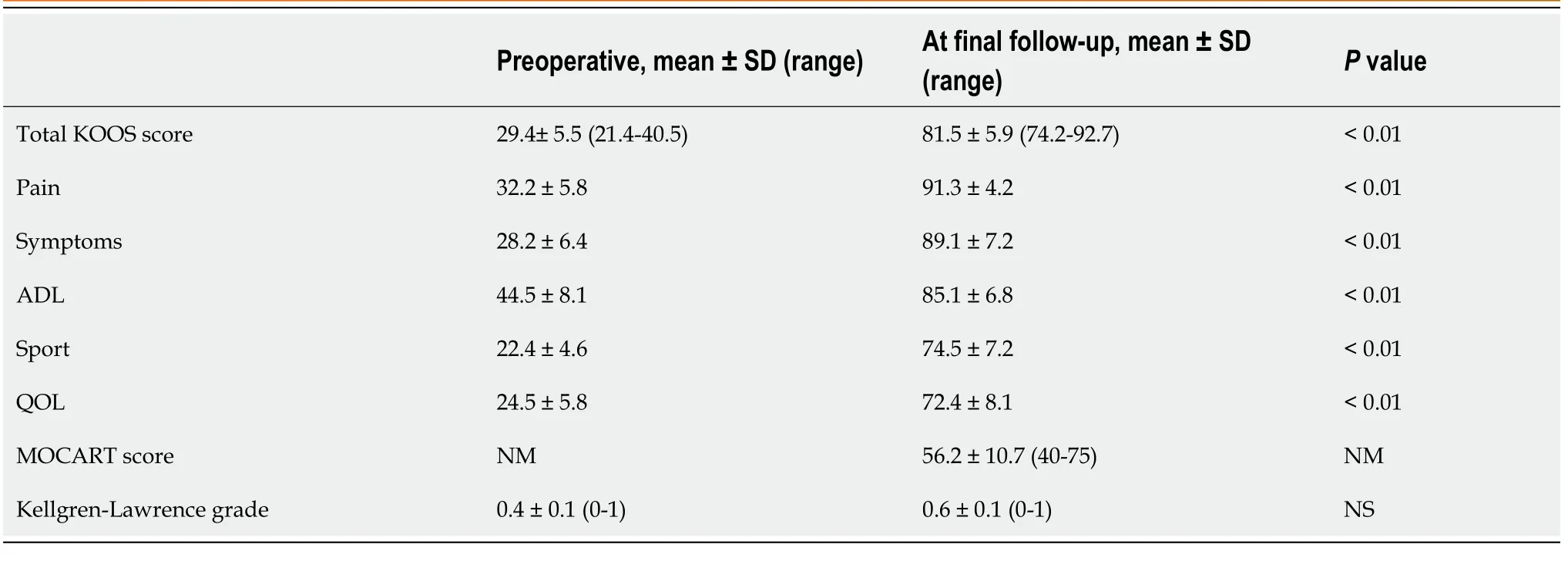
Table 2 Clinical and radiological results of patients
The mean MOCART score was found 56.2 ± 10.7 (range, 40-75) at last follow-up. There was no significant correlation between the total MOCART and KOOS scores. Preoperatively, all of the patients had Kellgren–Lawrence grades of 0–1; during the follow-up period, 80% (= 16) of the patients no showed radiographical progression of osteoarthritis (Figure 2). Patients with less than 4 cmlesion had statistically significantly better overall KOOS (0.01) than patients whose more than 4 cmlesion. In terms of the KOOS subscales, however, this was true only with sport (= 0.01) and quality of life (= 0.02). There were no statistically significant differences in the subscales pain, symptoms and activity of daily living (Figure 3).
Second-look arthroscopy was performed during contralateral knee operation to the patients who was operated from both knees at one year intervals. Second look arthroscopy view at 1-year follow-up of ICRS grade 4 of medial femoral condyle showing filling of the defect with a well-integrated, smooth surfaced and stable regenerated cartilage. The graft adaptation and incorporation were assessed to be excellent (Figure 4).
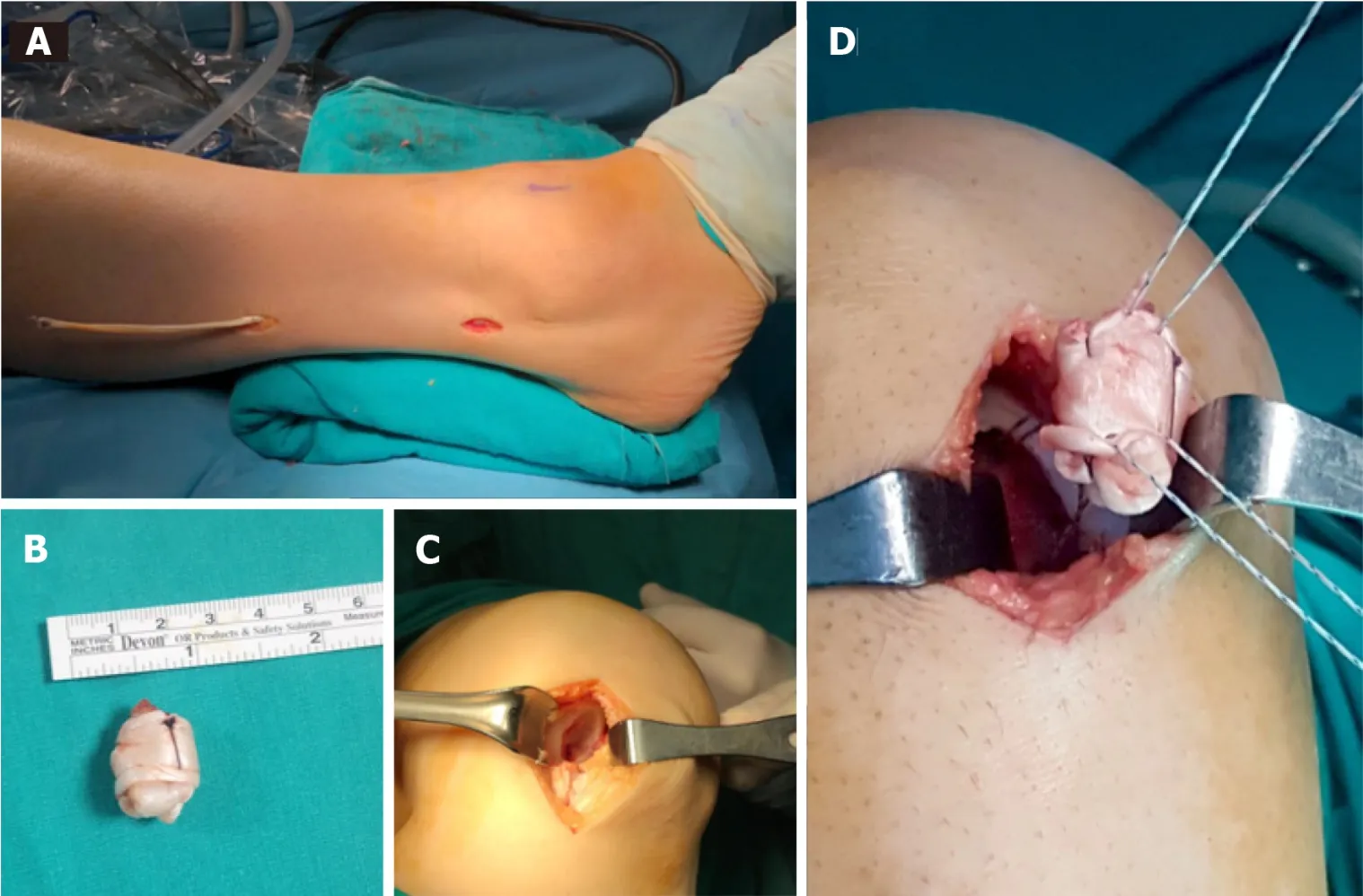
Figure 1 The technique of harvesting the autologous peroneal tendon from the donor area and placing it in the prepared osteochondral lesion area of the knee.
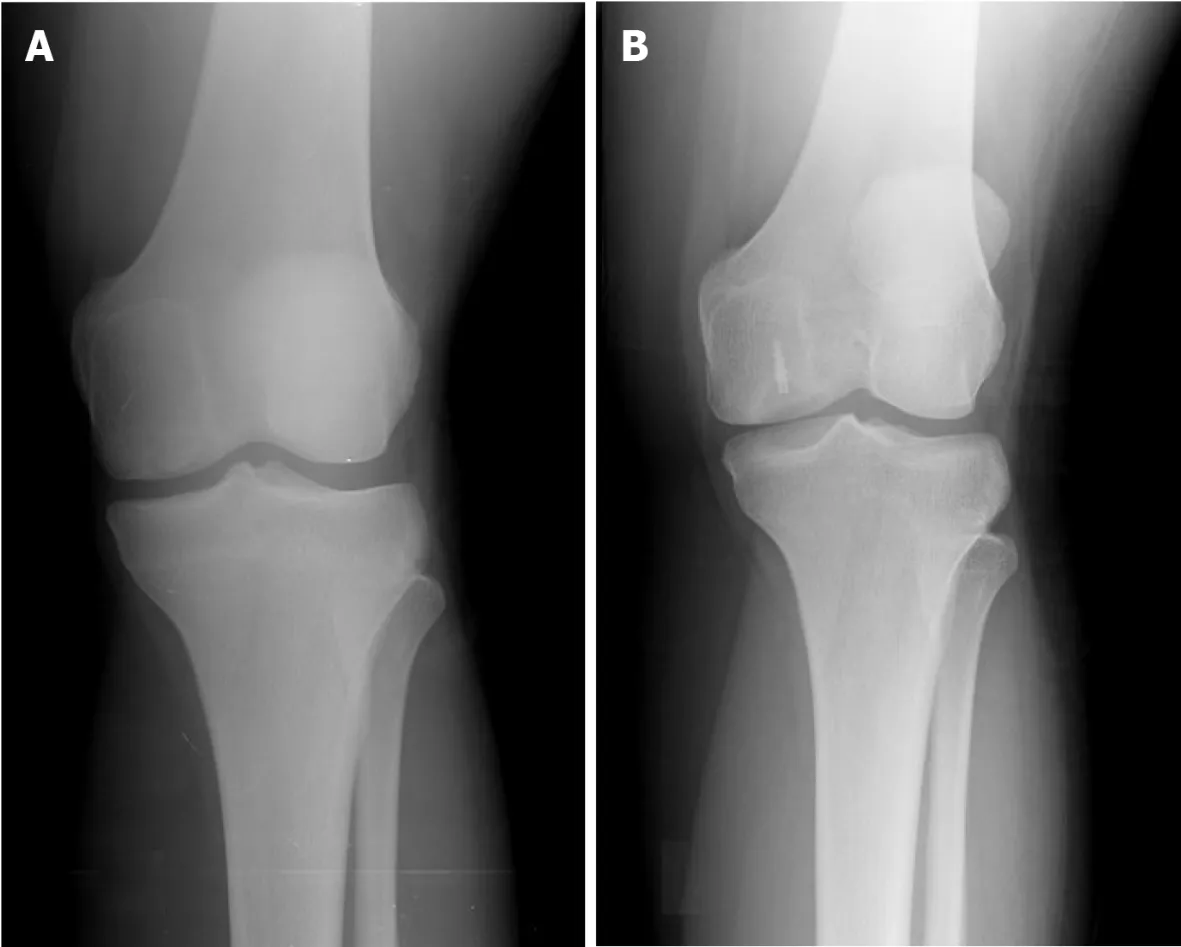
Figure 2 Radiographic images of a patient treated with the Autologous Tendon Transplantation technique.
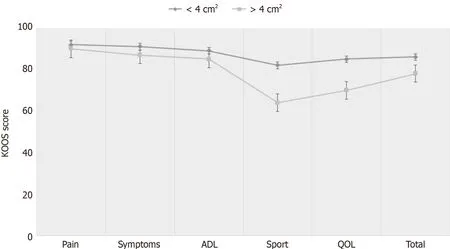
Figure 3 Knee injury and osteoarthritis outcome scores for different defect size.
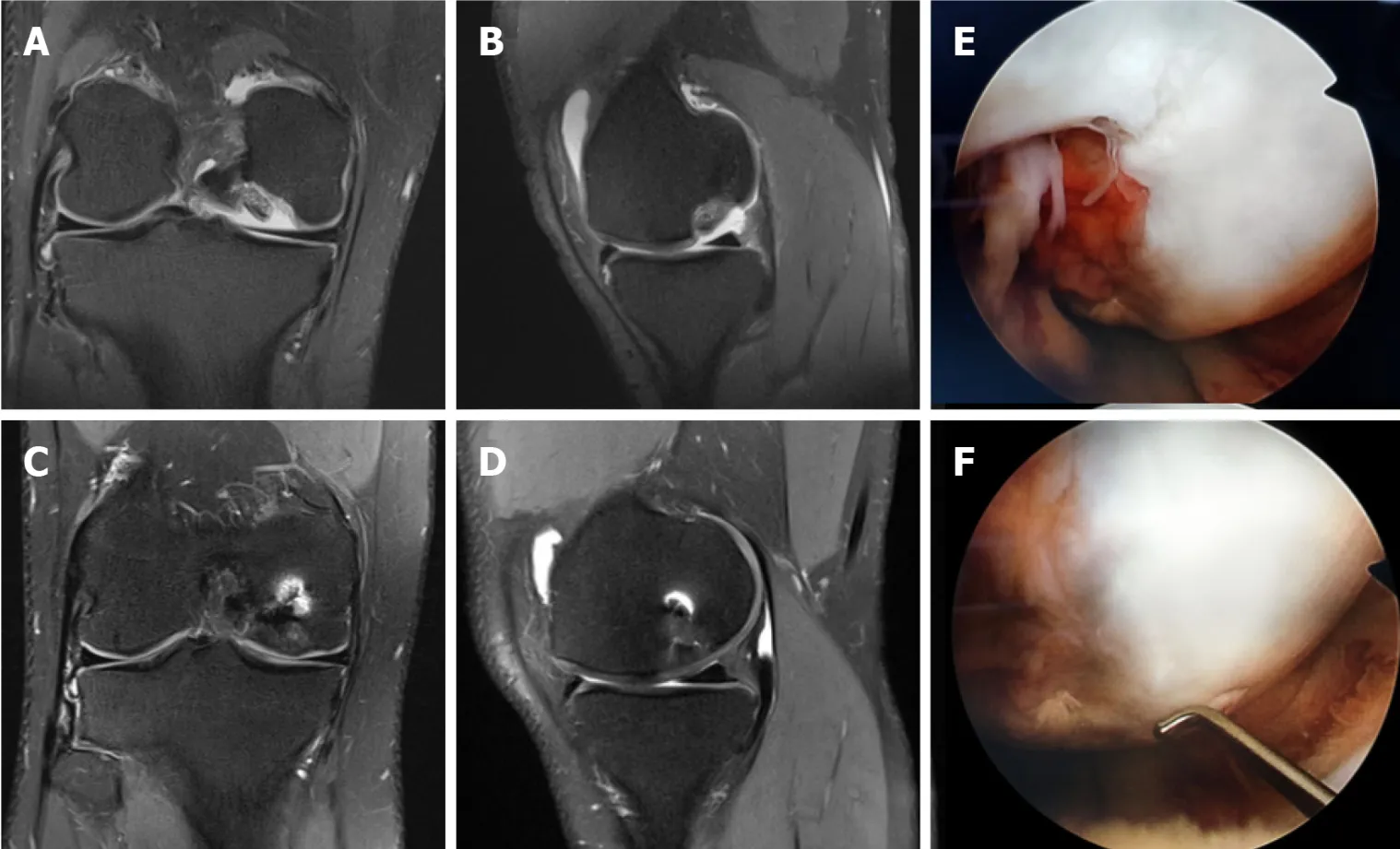
Figure 4 Magnetic resonance images and intraoperative images of a patient treated with the Autologous Tendon Transplantation technique.
Peroneus longus tendons were used as autologous grafts in all patients. No complications developed in any patient regarding donor site. In the graft donor site, no patient reported a neurological symptom. Hypertorphic scar tissue did not occur in any of the patients in the donor site. At the end of the 6th month, all patients returned to their daily work and daily activities without any restrictions.
DISCUSSION
The most important finding of the present study is that all of the patients treated with autologous tendon transplantation had “excellent and good” clinical and radiological outcomes with minimum 2 years follow-up. All parameters of the KOOS score improved significantly (0.001). Patients with less than 4 cmlesion had statistically significantly better overall KOOS (0.01) than patients whose more than 4 cmlesion.
The main aim in the treatment of osteochondral defect is to restore joint integrity by creating a tissue that is the same or similar to the biomechanical properties of the articular cartilage. This is the basic logic of this method. The reason we think of using tendons in the treatment of OCD is that the tendon has a viscoelastic and anisotropic structure that has main tasks of carrying energy from muscle to bone and storing energy with its highly organized hierarchy[13-15]. Tendons have been proven to increase their amounts of proteoglycan and glycosaminoglycan present in the matrix under compression conditions, and can resist compressive loads thanks to these two substances[13,15,16]. Another feature of the tendons is that they can change their structures and compositions in case of mechanical load changes. Cells in the tendon are responsible for adaptive changes and can alter gene expression, protein synthesis and cell phenotype against mechanical load. In addition, the extracellular matrix of the tendon acts as a scaffold, allowing cell adhesion, development, and differentiation[16,17]. Joint compliance is easily provided by the elastic structure of the tendon, hence solid structure forms a load carrying surface; thus, the pain is eliminated, joint functions are preserved and degeneration is stopped. The results of this technique we have described show that we have achieved this.
The technique we have described is actually a tissue-based cartilage repair technique. Therefore, it can be compared with osteochondral autograft or allograft repair techniques, which are tissue-based repair techniques. The most important advantage of the osteochondral autograft technique is that the graft is autograft and it enables the subchondral tissue to be restored[18]. But it has potential disadvantages such as donor site morbidity and poor joint compliance. In addition, the larger the defect area is, the higher the risk of complications are[19]. The osteochondral autograft technique may exhibit mismatch in connection geometry at the recipient site. In addition, the need for multiple grafts in large lesions complicates the provision of joint geometry and increases donor site morbidity. This can cause premature degeneration of the graft and joint, synovitis, and pain[20-23].
Another tissue-based cartilage repair technique is osteochondral allografts. These allografts have been used for many years in orthopedic surgery to reconstruct osteochondral defects[24]. It has also become an option in the treatment of cartilage abnormalities affecting subchondral bones, such as osteochondritis dissecans[25]. Osteochondral allograft is a highly beneficial procedure especially in the treatment of large lesions that are between the sizes 2-20 cmand in the treatment of a failed OCD[26-29]. Even if successful results have been reported in previous studies, the most important disadvantage of osteochondral allografts are their shorter storage life. Williams[30] in their study; reported that fresh human osteochondral allograft tissue that was kept for more than fourteen days, preserves its glycosaminoglycan content and biomechanical properties, yet it significantly loses its chondrocyte viability, viable cell density and metabolic activity. Other disadvantages of this method are the difficulty of accessibility to the graft, immunogenicity and graft rejection, the risk of disease transmission such as HIV and Hepatitis, disjointedness in joint geometry and collapse problems[25,31]. With the autograft we used, the disadvantages of osteochondral allografts are avoided.
The most important limitation of this study is the small number of patients. Even if we compare the study with previous studies, the absence of a control group is another limitation. Cartilage evaluation was evaluated with standart (1.5 Tesla system (Avanto; Siemens Medical Solution, Erlangen, Germany) MRI. Another shortcoming is that we did not perform imaging with gadolinium-enriched MRI.
CONCLUSION
This technique allows to avoid many of the disadvantages of other techniques. Important advantages; It is done in one step, it is an autograft, it does not require additional cost and it is easy to apply. Since it is an autograft, there is no risk of tissue rejection and contagious infection. Similar clinical and radiological results were obtained when compared to other treatment modalities. The autologous tendon transplantation is a single-step, safe, simple, cost-effective method for the treatment of knee OCD with satisfactory clinical and radiological outcomes, particularly in patients with less than 4 cmlesion.
ARTICLE HIGHLIGHTS
Research background
This research was initiated by being inspired by the article titled "Treatment of osteochondral defects with tendon autografts in a dog knee model" made in 1999 and the articles titled "Tendon regeneration: an anatomical and histological study in sheep"published in 2004.
Research motivation
Our teacher Ahmet Uğur Turhan's interest in joint surgery and his publications in 1999-2004 inspired him.
Research objectives
In order to protect the knee joint, the authors share the new technique with the world,and share the results with the world and to inspire new publications.
Research methods
A report of multiple patients with the same treatment, but no control group or comparison group.
Research results
All parameters of the knee injury and osteoarthritis outcome score (KOOS) score improved significantly in all patients. Patients with lesions less than 4 cm2 had a significantly better overall KOOS than patients with lesions greater than 4 cm2.
Research conclusions
Autologous tendon transplantation has satisfactory clinical and radiological results in patients with osteochondral lesions of the knee.
Research perspectives
The autologous tendon transplantation is a single-step, safe, simple, cost-effective method for the treatment of knee osteochondritis dissecans with satisfactory.
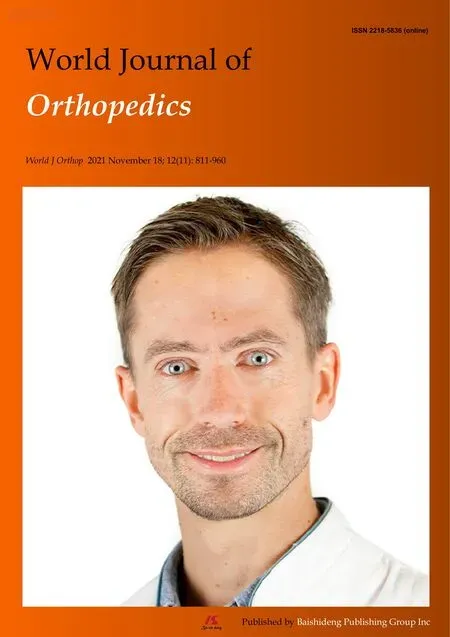 World Journal of Orthopedics2021年11期
World Journal of Orthopedics2021年11期
- World Journal of Orthopedics的其它文章
- Management of acute length-unstable Monteggia fractures in children: A case report
- Spontaneous pneumothorax in a 17-year-old male patient with multiple exostoses: A case report and review of the literature
- Pathological humerus fracture due to anti-interferon-gamma autoantibodies: A case report
- Allergic dermatitis after knee arthroscopy with repeated exposure to Dermabond Prineo™ in pediatric patients: Two case reports
- Role of coatings and materials of external fixation pins on the rates of pin tract infection: A systematic review and meta-analysis
- Femoral lengthening in young patients: An evidence-based comparison between motorized lengthening nails and external fixation
